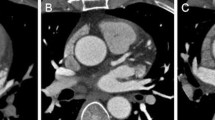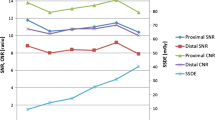Abstract
Purpose
To compare the impact of a 100 kV tube voltage protocol to 120 kV in terms of image quality and radiation dose by a 320 row coronary computed tomography angiography (CCTA) with automatic exposure control (AEC).
Materials and methods
Using a propensity matched analysis we compared a group of 135 patients scanned using a 100 kV tube voltage protocol with a group of 135 subjects scanned employing a 120 kV tube voltage setting. In all subjects the heart rate (HR) was <65 bpm and all CT scans were acquired using a prospective ECG gating and AEC strategy. Mean effective radiation dose and subjective and objective (Noise or N, signal to noise ratio or SNR, contrast to noise ratio or CNR) image quality, were evaluated. Subjective quality was assessed by two experienced radiologists using a 5-point scale (0: non diagnostic—4: excellent) using the 15-segment American Heart Association (AHA) coronary artery classification.
Results
Mean effective dose and noise were non significantly different between the two groups: mean effective dose was 2.89 ± 0.7 mSv in the 100 kV group and 2.80 ± 0.57 mSv in the 120 kV group (p = 0.25) while noise was 28.9 ± 3.3 in the 120 kV group and 29.05 ± 3.6 in the 100 kV group (p = 0.72). Both SNR and CNR were significantly higher in the 100 kV group than in the 120 kV group. This data agrees with the evidence that subjective quality was significantly higher in the 100 kV group in the middle and distal segmental classes.
Conclusion
Our study shows that, in using a 320 row CCTA with AEC strategy it is better to employ a 100 kV tube voltage protocol because compared to 120 kV tube voltage setting, it appears to significantly improve both subjective and objective image quality without decreasing the mean effective radiation dose.


Similar content being viewed by others
References
Lloyd-Jones D, Adams RJ, Brown TM, Carnethon M, Dai S, De Simone G, Ferguson TB, Ford E, Furie K, Gillespie C, Go A, Greenlund K, Haase N, Hailpern S, Ho PM, Howard V, Kissela B, Kittner S, Lackland D, Lisabeth L, Marelli A, McDermott MM, Meigs J, Mozaffarian D, Mussolino M, Nichol G, Roger VL, Rosamond W, Sacco R, Sorlie P, Stafford R, Thom T, Wasserthiel-Smoller S, Wong ND, Wylie-Rosett J, American Heart Association Statistics Committee and Stroke Statistics Subcommittee (2010) Executive summary: heart disease and stroke statistics – 2010 update: a report from the American Heart Association. Circulation. 121(7):948–954. doi:10.1161/CIRCULATIONAHA.109.192666
Einstein AJ, Henzlova MJ, Rajagopalan S (2007) Estimating risk of cancer associated with radiation exposure from 64-slice computed tomography coronary angiography. JAMA 298(3):317–23
Di Cesare E, Gennarelli A, Di Sibio A, Felli V, Splendiani A, Gravina GL, Barile A, Masciocchi C (2014) Assessment of dose exposure and image quality in coronary angiography performed by 640-slice CT: a comparison between adaptive iterative and filtered back-projection algorithm by propensity analysis. Radiol Med 119(8):642–649. doi:10.1007/s11547-014-0382-3
Di Cesare E, Carbone I, Carriero A, Centonze M, De Cobelli F, De Rosa R, Di Renzi P, Esposito A, Faletti R, Fattori R, Francone M, Giovagnoni A, La Grutta L, Ligabue G, Lovato L, Marano R, Midiri M, Natale L, Romagnoli A, Russo V, Sardanelli F, Cademartiri F; Working Group of the Cardiac Radiology Section of the Italian Society of Medical Radiology (SIRM) (2012) Clinical indications for cardiac computed tomography. From the Working Group of the Cardiac Radiology Section of the Italian Society of Medical Radiology (SIRM). Rad Med 117(6):901–938
Di Cesare E, Gennarelli A, Di Sibio A, Felli V, Splendiani A, Gravina GL, Masciocchi C (2015). Image quality and radiation dose of single heartbeat 640-slice coronary CT angiography: A comparison between patients with chronic Atrial Fibrillation and subjects in normal sinus rhythm by propensity analysis. Eur J Radiol 84(4): 631–636. doi: 10.1016/j.ejrad.2014.11.035
Lee CH, Goo JM, Ye HJ, Ye SJ, Park CM, Chun EJ, Im JG (2008) Radiation dose modulationtechniques in the multidetector CT era: from basics to practice. Radiographics 28(5):1451–1459. doi: 10.1148/rg.285075075
Austen WG, Edwards JE, Frye RL, Gensini GG, Gott VL, Griffith LS, McGoon DC, Murphy ML, Roe BB (1975). A reporting system on patients evaluated for coronary artery disease. Report of the Ad Hoc Committee for Grading of Coronary Artery Disease, Council on Cardiovascular Surgery, American Heart Association. Circulation 51(4 Suppl):5–40
Leipsic J, Labounty TM, Heilbron B, Min JK, Mancini GB, Lin FY, Taylor C, Dunning A, Earls JP (2010) Adaptive statistical iterative reconstruction: assessment of image noise and image quality in coronary CT angiography. AJR Am J Roentgenol 195(3):649–654. doi:10.2214/AJR.10.4285
Park EA, Lee W, Kim KW, Kim KG, Thomas A, Chung JW, Park JH (2012) Iterative reconstruction of dual-source coronary CT angiography: assessment of image quality and radiation dose. Int J Cardiovasc Imaging 28(7):1775–1786. doi:10.1007/s10554-011-0004-2
Chun EJ, Lee W, Choi YH, Koo BK, Choi SI, Jae HJ, Kim HC, So YH, Chung JW, Park JH (2008) Effects of nitroglycerin on the diagnostic accuracy of electrocardiogram-gated coronary computed tomography angiography. J Comput Assist Tomogr 32(1):86–92. doi: 10.1097/rct.0b013e318059befa
Bittencourt MS, Schmidt B, Seltmann M, Muschiol G, Ropers D, Daniel WG, Achenbach S (2011) Iterative reconstruction in image space (IRIS) in cardiac computed tomography: initial experience. Int J Cardiovasc Imaging 27:1081–1087.doi: 10.1007/s10554-010-9756-3
Yoo RE, Park EA, Lee W, Shim H, Kim YK, Chung JW, Park JH (2013) Image quality of adaptive iterative dose reduction 3D of coronary CT angiography of 640-slice CT: comparison with filtered back-projection. Int J Cardiovasc Imaging 29(3):669–676. doi:10.1007/s10554-012-0113-6
Hara AK, Paden RG, Silva AC, Kujak JL, Lawder HJ, Pavlicek W (2009) Iterative reconstruction technique for reducing body radiation dose at CT: feasibility study. AJR Am J Roentgenol 193(3):764–771. doi: 10.2214/AJR.09.2397
Bongartz G, Golding SJ, Jurik AG et al (2004). European Guidelines for Multislice Computed Tomography. Funded by the European Commission; EUR 16262 EN
Rubin DB (1997) Estimating causal effects from large data sets using propensity scores. Ann Intern Med 127(8 Pt 2):757–763
Cohen J (1960) A coefficient of agreement for nominal scales. EducPsycholMeas 20:37–46
Bischoff B, Hein F, Meyer T, Hadamitzky M, Martinoff S, Schoemig A, Hausleiter J (2009) Impact of a reduced tube voltage on CT angiography and radiation dose: results of the protection I study. JACC Cardiovasc Imaging 2(8):940–946
Leschka S, Stolzmann P, Schmid FT, Scheffel H, Stinn B, Marincek B, Alkadhi H, Wildermuth S (2008) Low kilovoltage cardiac dual-source CT: attenuation, noise, and radiation dose. EurRadiol 18(9):1809–1817
Zhang C, Zhang Z, Yan Z, Xu L, Yu W, Wang R (2011) 320-row CT coronary angiography: effect of 100-kV tube voltages on image quality, contrast volume, and radiation dose. Int J Cardiovasc Imaging 27:1059–1068. doi:10.1007/s10554-010-9754-5
Alkadhi H, Stolzmann P, Scheffel H, Desbiolles L, Baumuller S, Plass A, Genoni M, Marincek B, Leschka S (2008) Radiation dose of cardiac dual-source ct: the effect of tailoring the protocol to patient-specific parameters. Eur J Radiol 68(3):385–391. doi:10.1016/j.ejrad.2008.08.015
Blankstein R, Bolen MA, Pale R, Murphy MK, Shah AB, Bezerra HG, Sarwar A, Rogers IS, Hoffmann U, Abbara S, Cury RC, Brady TJ (2011) Use of 100 kV versus 120 kV in cardiac dual source computed tomography: effect on radiation dose and image quality. Int J Cardiovasc Imaging 27:579–586. doi:10.1007/s10554-010-9683-3
Szucs-Farkas Z, Verdun FR, von Allmen G, Mini RL, Vock P (2008) Effect of X-ray tube parameters, iodine concentration, and patient size on image quality in pulmonary computed tomography angiography: a chest-phantom-study. Invest Radiol 43(6):374–381. doi:10.1097/RLI.0b013e3181690042
Cademartiri F, Mollet NR, Lemos PA et al (2006) Higher intracoronary attenuation improves diagnostic accuracy in MDCT coronary angiography. AJR Am J Roentgenol 187:W430–W433
LaGrutta L, Galia M, Gentile G et al (2013) Comparison of iodinated contrast media for the assessment of atherosclerotic plaque attenuation values by CT coronary angiography: observations in an ex vivo model. Br J Radiol 86:20120238. doi:10.1259/bjr.20120238
Cademartiri F, La Grutta L, Palumbo A et al (2007) Imaging techniques for the vulnerable coronary plaque. Radiol Med. 112(5):637–659
Makaryus JN, Makaryus AN (2009) Coronary calcification: Achilles’ heel in the assessment for coronary artery disease in patients with symptomatic angina? Int J Cardiovasc Imaging 25(8): 855–857. doi: 10.1007/s10554-009-9535-1
Author information
Authors and Affiliations
Corresponding author
Ethics declarations
Conflict of interest
Authors declare no conflict of interest.
Ethical standards
This article does not contain any studies with human participants or animals performed by any of the authors.
Rights and permissions
About this article
Cite this article
Di Cesare, E., Gennarelli, A., Di Sibio, A. et al. 320-row coronary computed tomography angiography (CCTA) with automatic exposure control (AEC): effect of 100 kV versus 120 kV on image quality and dose exposure. Radiol med 121, 618–625 (2016). https://doi.org/10.1007/s11547-016-0643-4
Received:
Accepted:
Published:
Issue Date:
DOI: https://doi.org/10.1007/s11547-016-0643-4




